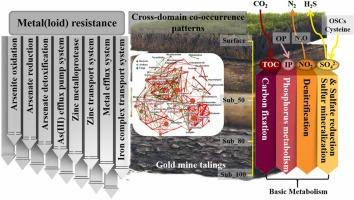Cross-Kingdom Microbial Interactions Drive Arsenic Detoxification and Functional Stabilization in Century-Old Mine Tailings
IF 11.3
1区 环境科学与生态学
Q1 ENGINEERING, ENVIRONMENTAL
引用次数: 0
Abstract
Legacy gold mine tailings pose persistent environmental risks due to sustained metal(loid) mobilization under acidic andoligotrophic conditions. This study investigated microbial community dynamics in 130-year-old tailings, comparing surface (0 - 10 cm) and subsurface (50 - 100 cm) layers. The tailings exhibited acidic conditions and nutrient oligotrophic, with elevated iron and arsenic concentrations. While mineralogical analysis identified quartz and lead arsenate (PbAs2O6) as dominant phases. Bacterial diversity decreased significantly with depth and community structure was depth-stratified, whereas fungal communities showed structural stability despite variations in richness. pH emerged as the primary factor influencing both bacterial and fungal community assembly, with metal(loid) concentrations also contributing to taxonomic distribution. Keystone taxa exhibited genetic potential for carbon fixation, phosphorus solubilization, and arsenic detoxification, with cross-domain co-occurrence suggesting functional complementarity. This study elucidates the microbial mechanisms underpining arsenic stabilization and nutrient cycling in century-old mine tailings, providing a foundation for targeted bioremediation strategies.

跨界微生物相互作用驱动百年尾矿中砷的解毒和功能稳定
由于在酸性和贫营养条件下持续的金属(样物质)迁移,遗留的金矿尾矿构成了持续的环境风险。研究了130年历史的尾矿表层(0 ~ 10 cm)和地下(50 ~ 100 cm)微生物群落动态。尾矿呈酸性,营养物质少营养,铁和砷浓度升高。矿物学分析鉴定石英和砷酸铅(PbAs2O6)为主要相。细菌多样性随深度显著下降,群落结构呈深度分层,而真菌群落在丰富度变化的情况下结构稳定。pH是影响细菌和真菌群落聚集的主要因素,金属(样蛋白)浓度也有助于分类分布。Keystone类群表现出固碳、增磷和砷解毒的遗传潜力,跨结构域共存表明功能互补。本研究阐明了百年尾矿中砷稳定和养分循环的微生物机制,为有针对性的生物修复策略提供了基础。
本文章由计算机程序翻译,如有差异,请以英文原文为准。
求助全文
约1分钟内获得全文
求助全文
来源期刊

Journal of Hazardous Materials
工程技术-工程:环境
CiteScore
25.40
自引率
5.90%
发文量
3059
审稿时长
58 days
期刊介绍:
The Journal of Hazardous Materials serves as a global platform for promoting cutting-edge research in the field of Environmental Science and Engineering. Our publication features a wide range of articles, including full-length research papers, review articles, and perspectives, with the aim of enhancing our understanding of the dangers and risks associated with various materials concerning public health and the environment. It is important to note that the term "environmental contaminants" refers specifically to substances that pose hazardous effects through contamination, while excluding those that do not have such impacts on the environment or human health. Moreover, we emphasize the distinction between wastes and hazardous materials in order to provide further clarity on the scope of the journal. We have a keen interest in exploring specific compounds and microbial agents that have adverse effects on the environment.
 求助内容:
求助内容: 应助结果提醒方式:
应助结果提醒方式:


